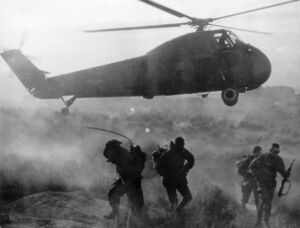Zimbaya War
| Zimbaya War | |||||||
|---|---|---|---|---|---|---|---|
 Kathic HC-44 picking up troops in the Zourfas Mountains | |||||||
| |||||||
| Belligerents | |||||||
|
|
| ||||||
| Commanders and leaders | |||||||
|
|
| ||||||
| Strength | |||||||
|
| ||||||
| Casualties and losses | |||||||
|
91,342 killed 200,000-300,000 wounded |
100,000-250,000 killed 231,000 wounded | ||||||
| 480,000 civilians killed or wounded | |||||||
The Zimbaya War also known as the Zimbayan War of Independence was a war between Kathia and later the State of Zimbaya against the Communist forces of the Provisional Democratic Republic of Zimbaya between 12 April 1955 and the fall of Al-Kaas on 3 May 1977. An important decolonization war, the war had lasting impacts on Kathic and Zimbayan society, including a rising distrust in the government in Kathia. The war was long and complex, with various groups fighting along side the Kathic forces and later the State of Zimbaya which served as the official transitional government from 1964 through 1977.
The war started when members of the People's Liberation Front and the Internal Liberation Forces of Zimbaya attacked a Kathic military instillation on 12 April 1955, and declared that a free Zimbaya would rule the territory currently administered by Kathia under the name the Democratic Republic of Zimbaya. Kathic forces retaliated with attacks on groups suspected of hiding out in the El-Maan hills. The force Kathic troops used failed to win over the Zimbayan population, and seeing any sort of attempt at keeping the land as part of Kathia as a futile effort, the nation gained nominal independence in 1964 as the State of Zimbaya. The State of Zimbaya gained full independence later that year and established its own armed forces. Groups who were assisting Kathic troops were grouped into the newly formed National Defense Forces of Zimbaya.
Peace negotiations began in the Spring of 1967 after the war had become an effective stalemate, however any solution was killed when PDRZ leaders left the Veranium Conference in 1968, further dragging out the war. The war had grown long and was becoming expensive. And as Kathic casualties mounted, those who opposed the war became more vocal. Anti-War activists became more vocal following the death of Prime Minister Acathe ce Vera in 1970, and when a report by the Vydau Dispatch released a report detailing how the government had covered up Kathic war crimes committed against Zimbayans. Gustava Curivan-Mauirszal won the 1972 election under the promise to pull Kathia out of the war gradually, and in early 1976 had fulfilled his promise. Byt this time, NDFZ forces had been losing ground, the communist forces were nearing the capital of Al-Kaas. Finally, PDRZ forces captured the city and the war came to an end.
Kathia continued its occupation of the Bir Talil islands and refused to establish diplomatic relations with the Democratic Republic of Zimbaya. The State of Zimbaya continued to survive on the islands in exile until 1986. The war ended up destabilizing and demoralizing the Zimbayan population, many who fled the nation to avoid reeducation camps. This came to a head when Khalid Ajam died in an apparent aircraft crash in 1981. Anti-communist forces subsequently started a 6 year long guerrilla war until the Democratic Republic of Zimbaya finally capitulated in the Spring Offensive in 1986.